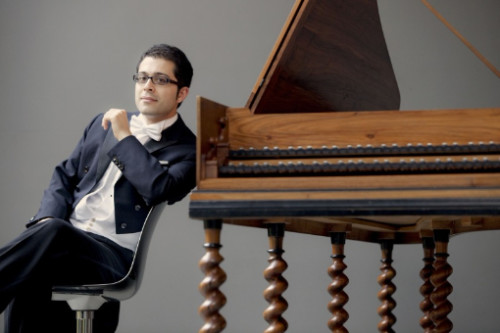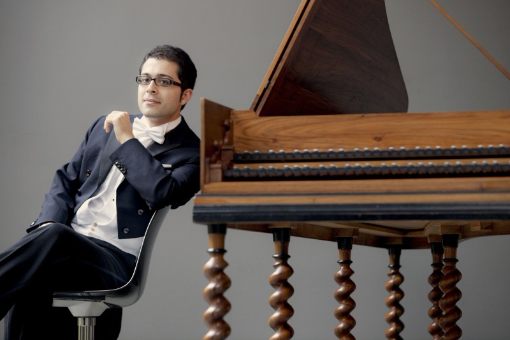 United Kingdom Bach: Mahan Esfahani (harpsichord). Wigmore Hall, London, 19.6.2018 (MB)
United Kingdom Bach: Mahan Esfahani (harpsichord). Wigmore Hall, London, 19.6.2018 (MB)

Bach – Clavier-Büchlein für Wilhelm Friedemann Bach: Nine Little Preludes, BWV 924-932; Toccata in E minor, BWV 914; Toccata in D minor, BWV 913; Capriccio on the Departure of his Most Beloved Brother, BWV 992; Clavier-Büchlein für Wilhelm Friedemann Bach: Five Little Preludes, BWV 939-943; English Suite no.6 in D minor, BWV 911
Mahan Esfahani opened my ears – and mind – not only to Bach on the harpsichord, but to the instrument itself. With this Wigmore Hall recital, he continued to do so. It was certainly not that I had ever thought Bach that ‘must’ be performed on the piano; that would be as absurd as saying that it must be performed on any other instrument(s). (Not that that prevents many from making such an absurd claim.) However, with a few exceptions, such as recordings from Wanda Landowska and Ralph Kirkpatrick, I had heard few interesting performances: performances that treated the music in anything more than naïve archaeological fashion. If you are neither able nor willing to hear the Schoenberg in Bach, just as much as the Bach in Schoenberg, then you might as well give up. If only the sectarian ayatollahs of ‘authenticity’ would – or indeed those who present an image founded upon silly hairstyles and other carefully manufactured ‘quirks’. Esfahani, however, with his insistence on the harpsichord as a living instrument, at home in Xenakis as Bach, in Ligeti as Byrd, shows us not that the choice of instrument is irrelevant; of course it is not. Esfahani shows us, as he did once again here, that he is a musician worthy of the supreme challenges with which Bach confronts him – and us.
Nine Little Preludes from the Clavier-Büchlein für Wilhelm Friedemann Bach made for a wonderful overture: not unlike, perhaps, a selection from Boulez’s Notations, for another instrument (about which I shall now shut up). There was a sense less of a conspectus, of a summa – this is not the 48 – but of new paths opening up: not least in the ninth, left incomplete in work and performance, the break theatrical in the best sense, a curtain-raiser rather than something applied from outside. Esfahani played these little pieces as a set, tonal progression again emerging from within: a sign of freedom, not a straitjacket. This is not the age of the Classical sonata, but of the suite (all or mostly ‘in’ a single key): progression means something different here. It means something nevertheless, and holds implications both historical and musical.
Landowska’s style and indeed that of Willem Mengelberg came to mind in the E minor Toccata. I say ‘style’, but really I mean ‘spirit’ – not that one can or should dissociate style and idea, as Schoenberg would warn us. This, I felt, was a performance I should like to have given, if only I had the technical and indeed musical facility to do so. Esfahani revelled in the young Bach’s music, never trying to turn it into older Bach; why should he? Percussive moments seemed almost to suggest Scarlatti; indeed, there was more than a little of the Mediterranean, or rather a German’s longing for the Mediterranean, to the performance. Perhaps I am sentimentalising, or applying my own preoccupations to what I heard. This was a performance open to personalisation, though – in the best sense. And Bach sounded, quite rightly, at least as radical as Ligeti. A bravura performance of the D minor Toccata followed. Following a slightly improvisatory opening, it teased and charmed; the performance compelled the music to speak, not unlike a recitativo accompagnato. This was Bach as generative as Beethoven or Brahms, albeit in somewhat different ways. It was anything but austere, the dialectic between freedom and organisation as spellbinding as it would be in any later composer, Schoenberg included.
Registration choices truly rang the changes – musical changes, no mere ‘effects’ – in a performance of the Capriccio on the Departure of his Most Beloved Brother that permitted of many standpoints or, perhaps better, ways in. Roots in earlier music came to life: living traditions in themselves. Chromaticism grew out of simple, diatonic beginnings. Something Italianate or at least ‘southern’ – Scarlatti again a kinsman? – sang in the exultation of homecoming. But it was Bach, and only Bach, who spoke, sang, and told of the glory of God in the fugue. Old ‘debates’ about programme music refuse to die, at least in the popular imagination; surely such music and performances ought to kill them off forever. It is never either/or.
Five further Preludes, BWV 939-43, opened the second half. Esfahani beginning very much in medias res. They sounded – regardless of questions concerned their ‘authenticity’ – as jewels in a Webern-like suite. Whoever wrote them, their quality spoke for itself; as, at least in performance, did their diversity in unity.
A Prelude in every sense opened the Sixth English Suite. We heard, experienced a youthful, exhilirating representation of chaos: something I fancied both Landowska and Alfred Cortot would have appreciated. The Allemande and Courante seemed almost to function as secular(ish) – not that the distinction between sacred and secular is remotely meaningful for Bach, or indeed at all – versicle and response. Redemption seemed almost at hand, if not through our own works. The intrinsic grandeur of the Sarabande and its Double was released in a fashion that seemed haunted by an earlier ‘Englishness’: Purcell, perhaps, or Lawes. My expectations were confounded – in a good way – in the Gavottes, taken at quite a lick and all the better for it. The interplay between hands told a story just as it would in Liszt or Webern. The Gigue danced in, not despite, its almost Bergian density. And then, a surprise: a Fantasy in C minor, written apparently when Bach was only fifteen years old. I was delighted to make its acquaintance. As ever with Bach, it looked backward and forward, those long, profound glances in mutual service. That, surely, should be how we strive to understand his music too; such was certainly the case here.
Mark Berry
For more about Mahan Esfahani click here.
